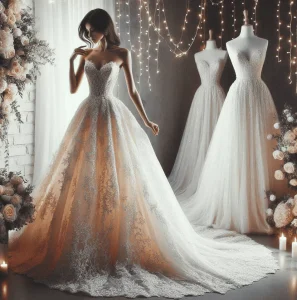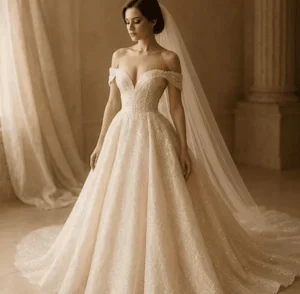Wedding Traditions – The Reason Behind Most Wedding Traditions

The Wedding Dress and Veil
The color of the bride’s dress is perhaps one of the most well-known of all wedding traditions. Since the 16th century the color white has been associated with purity and maidenhood. Many also accredit the tradition of wearing white to Queen Victoria who decided to forgo the usual color of silver. Before that, women simply married in their best dress in a color of their choosing.
It is said that one of the main purposes of the wedding veil dates back to the time of arranged marriages. The family of the bride may have been fearful that her potential husband would flee if she didn’t meet his expectations. The bride then wore a veil up until the time her father gives her away to the groom.
Originally worn by ancient Roman brides, the veil also served the purpose of protecting them from evil spirits by acting as a disguise.
Something Old…
The Victorian era gave us this popular wedding rhyme:
Something old, something new
Something borrowed, something blue
A silver sixpence in your shoe
“Something old” refers to the hopes that old friends will remain close during marriage. The bride was usually given an old garter to wear by a woman who has long been happily married herself. “Something new” is used to symbolize the couple’s new, and hopefully, prosperous future together.
“Something borrowed” is usually a valued object lent to the bride by her family. Returning the item ensures she will have good luck. The custom of “something blue” is said to have began many years ago in Israel when brides wore blue ribbons in their hair as a representation of fertility.
“A silver sixpence in your shoe” was used to ensure the newlyweds had plenty of wealth in their married lives. Although today most brides opt for a penny in the shoe as silver sixpences aren’t as common as they once were.
The Bridesmaids
A superstitious tradition dating back for centuries, female attendants at the wedding, known as bridesmaids, were actually necessary to protect the bride from evil spirits. They would dress similarly so that any malevolent beings lurking about would be confused and unable to cast their spells upon the bride. Today of course, bridesmaids are more useful for helping plan the wedding and attending to the bride on the big day.
The Wedding Cake
Tradition says that the bride must be the one to cut the cake first, lest the couple be cursed with a childless marriage. It is also thought to be unlucky for the new couple if all guests in attendance do not eat at least a small part of the wedding cake.
The bride must also keep one piece of cake to herself to ensure that her new husband remains faithful.
The Bouquet and Garter Toss
Tradition says that the woman who catches the bridal bouquet will be the next to enter married life. Similarly, the bride’s garter is tossed over the groom’s shoulder to the unmarried male guests who also hope to be the next marry.
The Honeymoon
The honeymoon is thought to date back to the days when the groom captured his bride, hiding them both away from her parents until they were with child. Honey wine was drank in hopes of boosting fertility as the phases of the moon passed, leading to the name honeymoon.



/julie-erik_01-ff49deac60eb4bb692b62054bc0482de.jpg)

